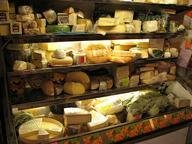Quiz Answer Key and Fun Facts
1. Adam begins his turophilic tour in a village in the county of Somerset, England. Considered to be the most popular in the country, which cheese comes from Somerset, near a particularly well-known gorge that was used during the production of the cheese way back when?
2. How does a Welshman eat his cheese? Well, Adam's about to find out. Which fatty Welsh cheese named for the town where it was first sold, aside from being tasty with a hint of sourness, is also known as the horrific punchline to the aforementioned joke?
3. Suitably satisfied so far, Adam turns his attention to the soft cheeses of France. Which deliciously creamy white cheese from the region of Normandy is popular both "as is" and baked?
4. Still not cheesed out, Adam makes his way to Italy to sample a rather famous blue cheese. Popular in Italian cooking, which sharp and, some might say, strong smelling cheese shares its name with a Milanese province, where it was first made?
5. Swinging past the Iberian peninsula on his tour of the continent, Adam scoops up a selection of Spanish cheeses, including one from Spain's historic La Mancha region. With thoughts of Cervantes' 'Don Quixote' going through his head, which cheese is Adam chowing down on now?
6. Making his way towards the Mediterranean, Adam finds himself hunting down more cheese. Traditionally associated with Greece, which salty, crumbly cheese is a highlight of many a Greek salad and a fine accompaniment to olives?
7. Still on the search, Adam picks up a salty Cypriot cheese that is most commonly fried, grilled or otherwise cooked in some way before consumption (though, of course, it can be eaten as is). What has he got his hands on now?
8. With his turophilic tastebuds tempted by thoughts of yet more cheese, Adam arrives in Switzerland, keen to sample what's on offer. Which typically Swiss cheese, sharing its name with the town where it was first created (as is the case with many cheeses), is used often in cooking, particularly in fondues and in some French dishes like quiches and the ever-popular French onion soup?
9. Had he not known better, Adam would have mistaken this next cheese for Emmental or Maasdam or other cheeses, given its holes. However, since he's in Scandinavia, he knows exactly what he's about to eat. Which delicious Norwegian cheese is named for the area in which it was first made (though it now forms part of Norway's Vestfold county)?
10. And so Adam reaches the end of his cheesy crusade, but not before sampling a small section of a certain red-skinned Dutch cheese. With which cheese is Adam ending his edible escapade?
Source: Author
eburge
This quiz was reviewed by FunTrivia editor
WesleyCrusher before going online.
Any errors found in FunTrivia content are routinely corrected through our feedback system.


